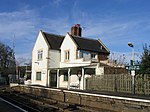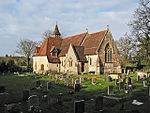Mottisfont

Mottisfont is a village and civil parish in the Test Valley district of Hampshire, England, around 4 miles (6.4 km) northwest of Romsey. The village is the location of Mottisfont Abbey. Much of the surrounding land, which is part of the Mottisfont Estate, and several other buildings in the village are in the care of the National Trust. The unusual name is probably derived from the Old English motes funta, meaning 'spring near the confluence' or 'spring of the moot' or possibly 'spring of the stone' (from the Old English motere: sonte).The village church is dedicated to St Andrew and its oldest parts date from the 12th century. Restorations were carried out in the 1870s and 1880s.Mottisfont formerly had a railway station on the Sprat and Winkle Line, which closed in the 1960s. The nearby Dunbridge station on the Wessex Main Line has recently been renamed as Mottisfont and Dunbridge. The Test Way and Monarch's Way long-distance footpaths pass through the village.
Excerpt from the Wikipedia article Mottisfont (License: CC BY-SA 3.0, Authors, Images).Mottisfont
Church Lane, Test Valley
Geographical coordinates (GPS) Address Nearby Places Show on map
Geographical coordinates (GPS)
| Latitude | Longitude |
|---|---|
| N 51.039553 ° | E -1.53711 ° |
Address
Church Lane 2
SO51 0LL Test Valley
England, United Kingdom
Open on Google Maps







